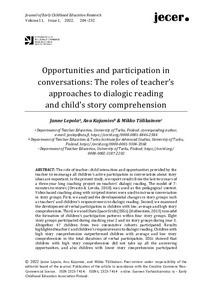Opportunities and participation in conversations: The roles of teacher’s approaches to dialogic reading and child’s story comprehension
Tiilikainen Mikko; Kajamies Anu; Lepola Janne
https://urn.fi/URN:NBN:fi-fe2022081154586
Tiivistelmä
The role of teacher–child interaction and opportunities provided by the teacher to encourage all children’s active participation in conversation about story ideas are important. In the present study, we report results from the last two years of a three-year long coaching project on teachers’ dialogic reading. The model of 7-minutes-to-stories (Orvasto & Levola, 2010) was used as the pedagogical context. Video-based coaching along with scripted stories were used to increase conversation in story groups. First, we analyzed the developmental changes in story groups such as teachers’ and children’s responsiveness to dialogic reading. Second, we examined the development of verbal participation in children with low, average and high story comprehension. Third, we used State Space Grids (SSGs) (Hollenstein, 2013) to model the formation of children’s participation patterns within four story groups. Eight story groups participated during coaching year 2 and six story groups during year 3. Altogether 47 children from two consecutive cohorts participated. Results highlighted teachers’ and children’s responsiveness to dialogic reading. Children with high story comprehension outperformed children with average and low story comprehension in the total durations of verbal participation. SSGs showed that children with high story comprehension did not take up all the answering opportunities, and also children with lower story comprehension participated actively in some groups. We discuss the benefits of long-term coaching for supporting changes in story group interaction and children’s participation.
Kokoelmat
- Rinnakkaistallenteet [19218]
